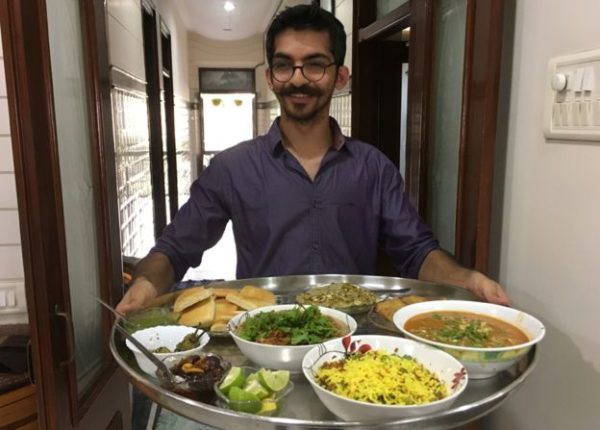Munaf Kapadia runs a successful “pop up” restaurant at his family’s home in Mumbai. His mother also works as head chef.
While watching TV one Sunday afternoon back in 2014, Munaf Kapadia had an argument with his mother that would change his life.
The then 25-year-old Google employee wanted to watch US cartoon the Simpsons, but as usual, his mother Nafisa preferred to see her favourite Indian soap opera and switched channels.
It got Mr Kapadia thinking.
His mum had lots of skills, but in his view she spent too much time watching bad TV.
Determined to get her doing something more meaningful, he struck upon an idea.
Nafisa had always been good at cooking “Bohri” food, an Indian cuisine that is much feted, but hardly served anywhere in their home city of Mumbai.
And so he decided to email 50 friends, inviting them for lunch at the family home.
“We settled on a group of eight friends of friends, and served them my mom’s food,” recalls Mr Kapadia, now 28.
“Then we started doing it every Saturday and Sunday, opening it up to the public and charging like a restaurant. That’s how The Bohri Kitchen was born.”
Traditionally, Bohri cuisine has only been available within the Dawoodi Bohra community, a small Muslim sect that lives in parts of India and Pakistan.
As Mr Kapadia says, “you literally had to beg Bohri friends or gatecrash Bohri weddings” to get a spoonful of it.
It blends Gujarati, Parsi, Mughlai and Maharastrian influences, and is often enjoyed by groups of friends or families, who eat from the same large steel platter, or “thaal”.
For his first “pop-up” lunch, Mr Kapadia charged guests 700 rupees (£8, $11) per head for a traditional seven-course banquet. By the time they had finished eating he knew the idea had potential.
“I was really shocked, but they actually hugged my mom. They said, ‘aunty, you have magic in your hands, this food is outstanding!’.”
He adds: “I saw the glint in my mom’s eyes when she got that acknowledgement, which she is not used to, because we in the family take her cooking for granted.
“That’s when I decided to just keep on doing this, I thought let’s try to keep getting new people exposed to my mother’s cooking skills.
So Mr Kapadia quit his marketing job at Google, and in January 2015 launched the “The Bohri Kitchen” as a brand.
Thanks to word-of-mouth publicity and some good reviews, it quickly gained a reputation among adventurous young food-lovers.
Mr Kapadia now charges 1,500 rupees per meal, typically offering lunches and occasional dinners at his parents’ home.
He has also launched a separate takeaway and catering business, which operates through the week, and employs three members of staff from outside the family.
The firm recently broke into profit and is now looking to open outlets across India.
But it hasn’t all been plain sailing. For one thing, it took Mr Kapadia a while to get used to hosting strangers in his home.
“We started a ‘no serial killer policy’, so customers can’t just book a seat, they have to ask for it,” he says. We then do a background check by calling them up and asking a few questions to make sure they’re legitimate.”
There have been other challenges too, including convincing his parents that he wasn’t crazy for leaving his job at Google, and learning how to hire good staff.
“My biggest challenge now is ensuring that our takeaway produces the same quality of food that my mother makes at home.”
Ravinder Yadav, of management consultancy Technopak Advisors, says that many Indian food businesses struggle to build a loyal customer base.
“These days, consumers in India have plenty of options when it comes to eating out. So making sure you know who your consumer is, and creating something that they will keep coming back to, is vital, even for the biggest brands.”
Still, he says in some respects things are getting easier.
“Finding investment is less of a challenge in India nowadays. And the government is making it easier to do business, so it’s simpler to get the licenses you need and to meet other regulations.”
India’s food services industry is also expanding fast. In the past decade, consumer spending power has grown, along with people’s appetite for eating out and ordering takeaways.
Mr Kapadia’s mother, the hidden culinary talent behind The Bohri Kitchen, says that the business has brought out a different side of her personality.
“I have never looked at this from a business angle, it’s just something that I love doing,” she says.
“And when guests say my food reminds them of home, it’s amazing. I get a lot of satisfaction and happiness.”
But has her son managed to wean her off her TV habit? Not likely, she says with a giggle.
“I still watch all my favourite soaps while cooking for our guests.”
Typical Bohri Kitchen dishes:
Mutton Khichda – goat meat cooked with dal and rice along with various Indian spices
Chana Bateta Thulli – chick peas and potatoes cooked in a tamarind-based sauce, served with cracked wheat
Chicken Angara – smoked chicken in a tomato-based gravy, served with homemade Indian flatbreads



Leave a reply